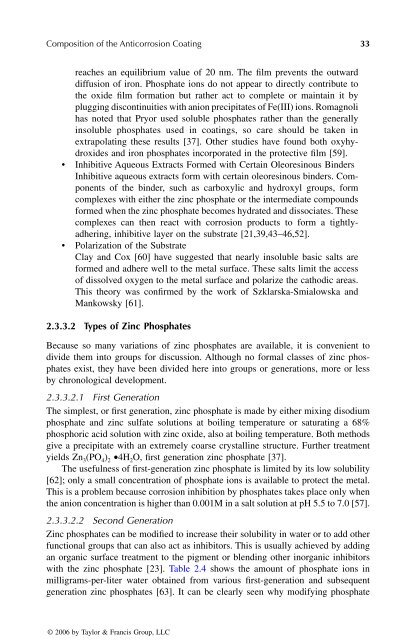© 2006 by Taylor & Francis Group, LLC
© 2006 by Taylor & Francis Group, LLC
© 2006 by Taylor & Francis Group, LLC
Create successful ePaper yourself
Turn your PDF publications into a flip-book with our unique Google optimized e-Paper software.
Composition of the Anticorrosion Coating 33<br />
reaches an equilibrium value of 20 nm. The film prevents the outward<br />
diffusion of iron. Phosphate ions do not appear to directly contribute to<br />
the oxide film formation but rather act to complete or maintain it <strong>by</strong><br />
plugging discontinuities with anion precipitates of Fe(III) ions. Romagnoli<br />
has noted that Pryor used soluble phosphates rather than the generally<br />
insoluble phosphates used in coatings, so care should be taken in<br />
extrapolating these results [37]. Other studies have found both oxyhydroxides<br />
and iron phosphates incorporated in the protective film [59].<br />
• Inhibitive Aqueous Extracts Formed with Certain Oleoresinous Binders<br />
Inhibitive aqueous extracts form with certain oleoresinous binders. Components<br />
of the binder, such as carboxylic and hydroxyl groups, form<br />
complexes with either the zinc phosphate or the intermediate compounds<br />
formed when the zinc phosphate becomes hydrated and dissociates. These<br />
complexes can then react with corrosion products to form a tightlyadhering,<br />
inhibitive layer on the substrate [21,39,43–46,52].<br />
• Polarization of the Substrate<br />
Clay and Cox [60] have suggested that nearly insoluble basic salts are<br />
formed and adhere well to the metal surface. These salts limit the access<br />
of dissolved oxygen to the metal surface and polarize the cathodic areas.<br />
This theory was confirmed <strong>by</strong> the work of Szklarska-Smialowska and<br />
Mankowsky [61].<br />
2.3.3.2 Types of Zinc Phosphates<br />
Because so many variations of zinc phosphates are available, it is convenient to<br />
divide them into groups for discussion. Although no formal classes of zinc phosphates<br />
exist, they have been divided here into groups or generations, more or less<br />
<strong>by</strong> chronological development.<br />
2.3.3.2.1 First Generation<br />
The simplest, or first generation, zinc phosphate is made <strong>by</strong> either mixing disodium<br />
phosphate and zinc sulfate solutions at boiling temperature or saturating a 68%<br />
phosphoric acid solution with zinc oxide, also at boiling temperature. Both methods<br />
give a precipitate with an extremely coarse crystalline structure. Further treatment<br />
yields Zn3(PO4) 2 •4H2O, first generation zinc phosphate [37].<br />
The usefulness of first-generation zinc phosphate is limited <strong>by</strong> its low solubility<br />
[62]; only a small concentration of phosphate ions is available to protect the metal.<br />
This is a problem because corrosion inhibition <strong>by</strong> phosphates takes place only when<br />
the anion concentration is higher than 0.001M in a salt solution at pH 5.5 to 7.0 [57].<br />
2.3.3.2.2 Second Generation<br />
Zinc phosphates can be modified to increase their solubility in water or to add other<br />
functional groups that can also act as inhibitors. This is usually achieved <strong>by</strong> adding<br />
an organic surface treatment to the pigment or blending other inorganic inhibitors<br />
with the zinc phosphate [23]. Table 2.4 shows the amount of phosphate ions in<br />
milligrams-per-liter water obtained from various first-generation and subsequent<br />
generation zinc phosphates [63]. It can be clearly seen why modifying phosphate<br />
<strong>©</strong> <strong>2006</strong> <strong>by</strong> <strong>Taylor</strong> & <strong>Francis</strong> <strong>Group</strong>, <strong>LLC</strong>
















